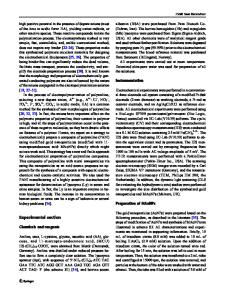Preparation, characterization and electrochemical application of an Ag/zeolite nanocomposite: application to sub-micromo
- PDF / 5,703,478 Bytes
- 10 Pages / 595.276 x 790.866 pts Page_size
- 61 Downloads / 369 Views
Preparation, characterization and electrochemical application of an Ag/zeolite nanocomposite: application to sub‑micromolar quantitation of tryptophan Seyedeh‑Fatemeh Mousavi1 · Mohammad Alimoradi1 · Abbas Shirmardi2 · Vahid Zare‑Shahabadi3
© Springer Science+Business Media, LLC, part of Springer Nature 2020
Abstract A silver zeolite (AgY) nanocomposite was prepared and applied for construction of a modified carbon paste electrode (AgY/ CPE) for sensing tryptophan (Trp) in real samples by using differential pulse voltammetry (DPV). AgY nanocomposite was prepared with a simple method from nano-structured sodium zeolite (NaY) and characterized by X-ray diffraction (XRD), field emission scanning electron microscopy (FESEM), Energy dispersive X-ray analysis (EDX). Particle size of the prepared AgY was in the range between 17.8 and 44.7 nm. Fourier transform infrared (FTIR) and fluorescence spectra AgY and AgY/Trp nanocomposites reveals interaction between AgY and Trp. Cyclic voltammetry (CV) was used for evaluating the electrode behaviour. Effect of potential scan rate on the electrode response was also studied. The proposed electrode revealed a suitable current response at scan rate of 0.1 V.s−1. A descriptive mechanism was proposed for explaining the electrode response toward Trp based on the CV experiments. Effect of pH on the response of the electrode was also studied. The modified carbon paste electrode revealed a good response to Trp at pH of 6.9 in a phosphate buffer solution (PBS), in the range of Trp concentration between 10 nM and 1.2 µM. The detection limit of the electrode was 6.3 nM and it was successfully applied for the determination of Trp in milk and samples. The accuracy and precision of the results were evaluated with statistical methods. Keywords Biomolecule · Tryptophan · Zeolite · Differential pulse voltammetry · Carbon paste electrode
1 Introduction As an important essential amino acid, Trp has a crucial effect in the metabolism of human body. Apart from protein synthesis, it is a precursor for serotonin, niacin and melatonin synthesis [1]. An appropriate level of Trp intake prevents and treats certain diseases such as Alzheimer’s disease, heart disease, psychotic depression, schizophrenia and hepatic disease [2–6]. Thus, the detection of Trp is significantly important for the development of medicine and technology. * Abbas Shirmardi [email protected] 1
Department of Chemistry, Faculty of Science, Arak Branch, Islamic Azad University, Arak, Iran
2
Department of Chemistry, Masjed‑Soleiman Branch, Islamic Azad University, Masjed‑Soleiman, Iran
3
Department of Chemistry, Mahshahr Branch, Islamic Azad University, Mahshahr, Iran
Different optical [7–9] and electrochemical sensors were used for determining different biomolecules [6, 10–19] ionic spices, [20–30], organic pollutants [31], anticancer drugs [32] and other pharmaceuticals [33] in real samples over the last three decades. These techniques offer advantages over other analytical techniques such as chromatography, sp
Data Loading...











